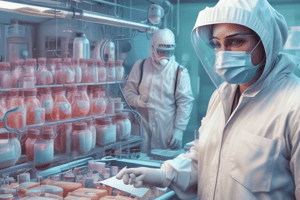Podcast
Questions and Answers
What is the main purpose of N95 respirators?
What is the main purpose of N95 respirators?
- To protect against fluid resistance
- To filter out at least 95% of airborne particles (correct)
- To protect against chemical exposure
- To provide barrier protection
Why are masks with exhalation valves not recommended for patient care?
Why are masks with exhalation valves not recommended for patient care?
- They cannot filter out airborne particles
- They do not provide barrier protection
- They are difficult to breathe through
- They increase the risk of contamination (correct)
What should be done if a gown is torn or wet?
What should be done if a gown is torn or wet?
- Wash it in place
- Continue using it until the end of the day
- Patch it up with duct tape
- Change it immediately (correct)
When removing PPE, what is the correct sequence for removal of garments?
When removing PPE, what is the correct sequence for removal of garments?
What is the correct way to handle the removal of a mask?
What is the correct way to handle the removal of a mask?
Why is proper donning and removal of PPE important during disasters?
Why is proper donning and removal of PPE important during disasters?
Why is the proper use and disposal of PPE considered crucial during disasters?
Why is the proper use and disposal of PPE considered crucial during disasters?
What is the primary purpose of Personal Protective Equipment (PPE)?
What is the primary purpose of Personal Protective Equipment (PPE)?
In the context of infectious disease management, what role does PPE play?
In the context of infectious disease management, what role does PPE play?
Why is the use of PPE essential during emergency response efforts?
Why is the use of PPE essential during emergency response efforts?
What is one specific type of PPE commonly used and mentioned in the text?
What is one specific type of PPE commonly used and mentioned in the text?
How does proper use of PPE help in disaster situations with victims exposed to bloodborne pathogens?
How does proper use of PPE help in disaster situations with victims exposed to bloodborne pathogens?
Study Notes
Infection Control Measures During Disaster Focusing on Personal Protective Equipment (PPE)
Infections can occur in various settings such as hospitals, residential care facilities, and natural disasters. During these events, it is crucial to implement infection control measures to minimize the spread of diseases. One of the most effective ways to do this is through the proper use and disposal of PPE.
What is PPE?
Personal Protective Equipment (PPE) refers to any devices worn by individuals to protect them from injury or exposure to hazardous environments. PPE includes items like gloves, masks, goggles, gowns, respirators, and helmets. It is used to reduce exposure to physical, chemical, biological, radiological, and infectious agents.
Importance of PPE
The use of PPE is essential during disasters because it helps prevent the spread of contagious diseases among those involved in emergency response efforts. Proper use of PPE reduces the risk of transmission of pathogens between responders, patients, and members of the public. This becomes particularly important when treating victims exposed to bloodborne pathogens, airborne particles, or other potentially infectious materials.
Types of PPE for Infection Control
There are different types of PPE designed for specific purposes within the context of infectious disease management:
Gloves
Disposable gloves made of synthetic materials are commonly used. They offer protection against chemical, thermal, and microbiological hazards. However, they must be removed properly after use to avoid cross-contamination.
Masks
Masks may be used for source control or respiratory protection. N95 respirators are often recommended for their ability to filter out at least 95% of airborne particles. However, masks with exhalation valves are NOT recommended for any type of patient care.
Gowns
Gowns can provide both barrier protection and fluid resistance depending on the material used. They should be changed immediately if soiled, torn, wet, or contaminated.
Eye Protection
Spectacles or face shields can help protect the eyes from splashes and sprays. If there is risk of chemical exposure, specialized eye protection is required.
Respirators
Respirators protect against airborne particulates, vapors, or gas mixtures. The type of respirator needed depends on the nature of the hazard.
How to Wear and Remove PPE
Proper donning and removal techniques for PPE ensure its effectiveness in infection control during disasters:
Donning PPE
For non-respiratory PPE:
- Hands must be clean before putting on PPE.
- Put gloves on first, followed by gown, mask, cap, and safety glasses or goggles.
- Use an alcohol swab to disinfect the skin under the respirator seal area.
- Push down on lower edge of respirator mask to form tight face seal.
To wear respirators:
- Ensure hands are clean.
- Put on respirator mask with headband over crown of head.
- Place headband around neck until snug fit.
- Raise straps into position above ears.
- Lower straps onto nape of neck to complete adjustment.
Removing PPE
After removal of PPE, always follow the manufacturer's instructions. For general guidelines:
Removal sequence: outer layer garments first, e.g., gown, then mask, then inner layer(s), e.g., gloves.
When removing a mask, hold the straps behind the ears and lift off your face without touching the front surface of the mask.
Handle all PPE removal with caution and avoid touching the outside of the mask or other PPE if possible.
By properly using and disposing of PPE, we can significantly reduce the risk of infections during disasters, ensuring the safety of those involved in emergency response efforts.
Studying That Suits You
Use AI to generate personalized quizzes and flashcards to suit your learning preferences.
Description
Learn about the importance of Personal Protective Equipment (PPE) during disasters, focusing on infection control measures. Understand the types of PPE such as gloves, masks, gowns, eye protection, and respirators, and the proper techniques for wearing and removing them to minimize the spread of diseases.




